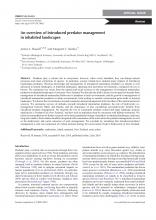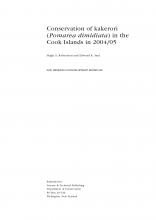Conservation of kakerori (Pomarea dimidiata) in the Cook Islands in 2004/05

BRB
Available Online
Robertson Hugh A
,
Saul Edward K
2006
In 1989, the kakerori (Pomarea dimidiata) was one of the ten rarest bird species in the world, with a declining population of just 29 birds living in south-eastern Rarotonga. As a result of conservation management, the kakerori population has rebounded, with a minimum of 281 birds on Rarotonga and 19 birds on Atiu in summer 2004/05. Since 2001, the emphasis of management in the Takitumu Conservation Area (TCA) on Rarotonga has shifted from the recovery of kakerori to sustaining the population at 250300 individuals. In 2004/05, all rat bait stations were filled fortnightly, and so the labour costs were reduced by 30% to 34 person days, and toxin use (57 kg of Talon®active ingredient brodifacoum) was reduced 81% from the peak year during the recovery phase. Kakerori breeding productivity was unusually high in 2004/05 because several pairs raised two broods. In the poisoned area, apparent breeding success was significantly higher (1.35 fledglings/breeding territory) than in the unpoisoned area (0.55 fledglings/ breeding territory); however, this difference was at least partly due to more effort being spent searching for fledglings in poisoned areas. A minimum of 59 fledglings was detected in 2004/05; however, some territories were not checked during the breeding season, and then a series of five tropical cyclones struck Rarotonga in a 4-week period in February/March 2005, which halted our fledgling searches, and caused severe damage to some habitat in the TCA. We expect that many kakerori perished during these cyclones; however, the population on Atiu, which was only affected by two of the five cyclones, survived unscathed. These catastrophic weather events highlighted the vulnerability of single-island endemic birds, and underlined the value of establishing an insurance population on Atiu. We recommend that the poisoning regime should return to that used during the recovery phase of the kakerori management programme if the August 2005 census reveals that the population has fallen below 220 birds (a 20% decline), otherwise the recent programme of fortnightly poisoning should continue.

